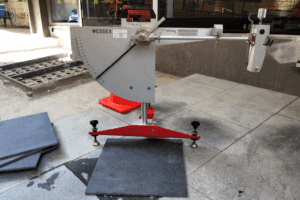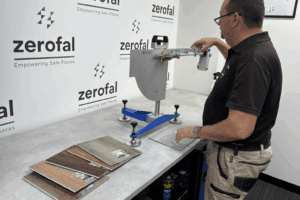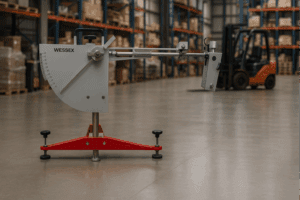Why Your Last Test Might Be Outdated
Slip resistance doesn’t last forever—and a test result only applies to the exact batch tested. A different batch, even if it’s the same product, must be tested separately. Wear, cleaning changes, coatings, or weather can all shift performance, so retest regularly.
Surface performance changes over time, and between batches. Passing an AS 4663–2013 test last year doesn’t guarantee compliance today.
If the floor has been sealed, re-polished, cleaned differently, worn down, or replaced with a new batch of product, the slip resistance can be very different.
Australian Standards make it clear: a slip resistance certificate is only valid for the specific batch tested. Even if the product’s style, manufacturer, size, and finish are identical, a different production batch requires its own test. Minor manufacturing variations can change the microtexture enough to shift the P-rating.
We regularly see surfaces drop 1–2 P-ratings due to:
- High foot traffic
- Changed cleaning chemicals
- New sealers or finishes
- Outdoor exposure and surface breakdown
- Variation between manufacturing batches
WHS obligations require safe surfaces to be maintained, not just tested once. Periodic retesting provides proof you’re actively managing risk, and batch-by-batch testing ensures product certificates are valid.
Suggested retest frequencies:
- Shopping centres / retail foyers: 6–12 months
- Schools and aged care: annually
- Surfaces treated or coated: test post-treatment and again within 12 months
- Each new batch of product: test before installation
Zerofal makes retesting straightforward. We track your previous results, flag at-risk areas, and clearly identify if new tests are needed for replacement or additional batches.
Need a Certified Slip Test?
Book your next AS 4663–2013 test now—don’t rely on an old certificate or a different batch’s results.
Explore more

Colour, Grit and Surface Finish: How Subtle Differences Change Slip Ratings (AS 4586:2013)
Colour, grit and finish change slip resistance. Learn why P-ratings vary across tile ranges and coatings

Why One Slip Test Isn’t Enough for Product Lines (AS 4586:2013)
Slip resistance varies across colours and finishes. Learn why one AS 4586 test cannot certify an entire product line.

Industrial Slip Resistance: Dust, Boots & Coating Drift (AS 4663:2013)
: Industrial floors change fast. Learn how dust, coatings and machinery reduce slip resistance and why AS 4663 onsite testing is essential.
Stay Ahead of Safety Standards
Join the Zerofal newsletter for actionable insights on slip testing, compliance updates, and smart prevention strategies. No spam – just practical safety advice.
